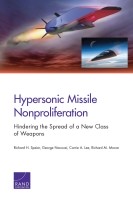| 来源类型 | Research Reports
|
| 规范类型 | 报告
|
| DOI | https://doi.org/10.7249/RR2137
|
| ISBN | 9780833099167
|
| 来源ID | RR-2137-CC
|
| Hypersonic Missile Nonproliferation: Hindering the Spread of a New Class of Weapons |
| Richard H. Speier; George Nacouzi; Carrie Lee; Richard M. Moore
|
| 发表日期 | 2017
|
| 出版年 | 2017
|
| 页码 | 154
|
| 语种 | 英语
|
| 结论 |
New Class of Threat- Hypersonic missiles are a new class of threat because they are capable both of maneuvering and of flying faster than 5,000 kilometers per hour, which would enable such missiles to penetrate most missile defenses and to further compress the timelines for response by a nation under attack.
- The proliferation of such missiles beyond the United States, Russia, and China could result in other powers compressing their response timelines in ways that set their strategic forces on hair-trigger states of readiness — such as a strategy of "launch on warning." And such proliferation could enable such states to more credibly threaten attacks on major powers.
Time Is Key- There is probably less than a decade available to substantially hinder the potential proliferation of hypersonic missiles and associated technologies.
- There appears to be interest in hypersonic missile nonproliferation and at least a few years available for relevant governments to put a policy in place.
International Concern- The unavoidable requirement is for the United States, Russia, and China to agree on a nonproliferation policy.
- France could play a key role in bringing other governments into agreement on a broader control policy.
- The technical and economic barriers to developing hypersonic technology are great enough to add to the effectiveness of a nonproliferation policy.
|
| 摘要 |
- A two-tiered approach to containing the spread of hypersonic systems and components appears to be the most promising.
- First, we recommend a policy of export denial for complete hypersonic delivery vehicles and enough major subsystems to effectively provide access to complete hypersonic missiles.
- Second, given dual-use concerns, we also recommend a policy of case-by-case export reviews for scramjets and other hypersonic engines and components, fuels for hypersonic use, sensors, navigation, and communication items for hypersonic flight, hypersonic flight controls, design tools and modeling for such uses, and ground simulation and testing for hypersonic systems.
- The necessary first step is for the United States, Russia, and China to agree not to export complete hypersonic missiles or their major subsystems. Beyond that, the control list recommended in this report can be the basis for international discussions.
|
| 主题 | Aerospace
; Air Defense
; Ballistic Missiles
; China
; Missile Defense
; Russia
; United States
|
| URL | https://www.rand.org/pubs/research_reports/RR2137.html
|
| 来源智库 | RAND Corporation (United States)
|
| 引用统计 |
|
| 资源类型 | 智库出版物
|
| 条目标识符 | http://119.78.100.153/handle/2XGU8XDN/108690
|
推荐引用方式
GB/T 7714 |
Richard H. Speier,George Nacouzi,Carrie Lee,et al. Hypersonic Missile Nonproliferation: Hindering the Spread of a New Class of Weapons. 2017.
|
|
文件名:
|
x1548705013100.jpg
|
|
格式:
|
JPEG
|

|
文件名:
|
RAND_RR2137.pdf
|
|
格式:
|
Adobe PDF
|
除非特别说明,本系统中所有内容都受版权保护,并保留所有权利。